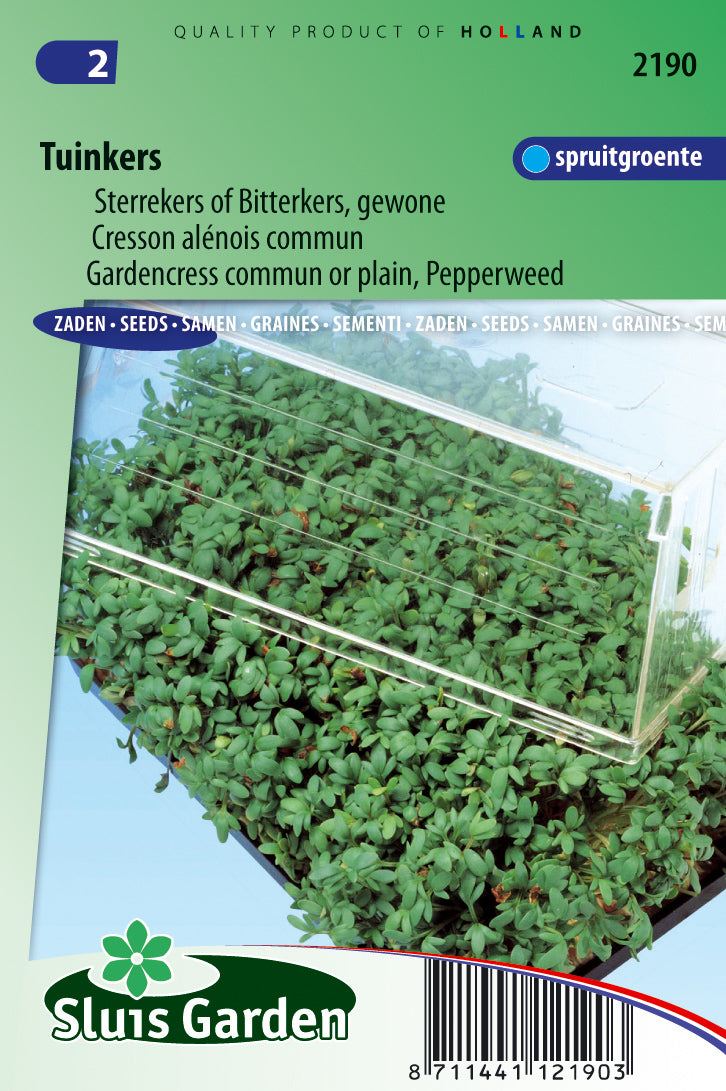1
/
of
1
Cress plain leaved Lepidium sativum
Cress plain leaved Lepidium sativum
Regular price
1.350 KWD
Regular price
Sale price
1.350 KWD
Unit price
/
per
Shipping calculated at checkout.
Couldn't load pickup availability
Growing plain-leaved cress (Lepidium sativum), also known as garden cress, is a quick and easy process. Cress is often grown for its tender, peppery leaves that are commonly used in salads and sandwiches. Here's a guide on how to grow cress:
**1. Planting Time:**
- Cress is a cool-season crop. It can be grown both indoors and outdoors. For outdoor cultivation, plant the seeds in early spring or early fall.
**2. Soil Preparation:**
- Cress prefers well-draining soil rich in organic matter. It can tolerate various soil types, but it grows best in fertile soil. Ensure the soil pH is around 6.0 to 7.0.
**3. Container Gardening:**
- Cress is well-suited for container gardening. Use a pot with drainage holes, fill it with potting mix, and sow the seeds directly in the container.
**4. Sowing Seeds:**
- Scatter the cress seeds over the soil surface. Lightly press them into the soil or cover them with a thin layer of soil. Cress seeds are tiny, so avoid planting them too deep.
**5. Sunlight:**
- Cress prefers partial shade to full sunlight. It can tolerate some shade, making it suitable for indoor cultivation.
**6. Watering:**
- Keep the soil consistently moist, especially during germination. Water the cress regularly, and ensure that the soil doesn't dry out completely.
**7. Germination:**
- Cress seeds germinate quickly, usually within 7-14 days. Once the seedlings are a couple of inches tall, you can start harvesting.
**8. Harvesting:**
- Harvest cress when the seedlings are 2-3 inches tall. Use clean scissors or shears to cut the leaves just above the soil level. Harvesting can usually begin about 2 weeks after sowing.
**9. Successive Planting:**
- For a continuous harvest, sow cress seeds successively every 2-3 weeks. This ensures a fresh supply of tender leaves.
**10. Companion Planting:**
- Cress is a good companion plant for other vegetables. It can help repel certain pests and attracts beneficial insects.
**11. Pests and Diseases:**
- Cress is generally resistant to pests and diseases. However, keep an eye out for aphids or caterpillars. Insecticidal soap can be used if needed.
**12. Indoor Cultivation:**
- Cress is well-suited for growing indoors on a windowsill. Use a shallow container filled with potting mix and follow the same steps for outdoor cultivation.
**13. Culinary Uses:**
- Cress has a peppery flavor and is often used in salads, sandwiches, and garnishes. It's a nutritious addition to your meals.
Growing plain-leaved cress is a quick and satisfying endeavor, making it a popular choice for both beginner and experienced gardeners. Enjoy the fresh, zesty flavor of homegrown cress in your culinary creations.
**1. Planting Time:**
- Cress is a cool-season crop. It can be grown both indoors and outdoors. For outdoor cultivation, plant the seeds in early spring or early fall.
**2. Soil Preparation:**
- Cress prefers well-draining soil rich in organic matter. It can tolerate various soil types, but it grows best in fertile soil. Ensure the soil pH is around 6.0 to 7.0.
**3. Container Gardening:**
- Cress is well-suited for container gardening. Use a pot with drainage holes, fill it with potting mix, and sow the seeds directly in the container.
**4. Sowing Seeds:**
- Scatter the cress seeds over the soil surface. Lightly press them into the soil or cover them with a thin layer of soil. Cress seeds are tiny, so avoid planting them too deep.
**5. Sunlight:**
- Cress prefers partial shade to full sunlight. It can tolerate some shade, making it suitable for indoor cultivation.
**6. Watering:**
- Keep the soil consistently moist, especially during germination. Water the cress regularly, and ensure that the soil doesn't dry out completely.
**7. Germination:**
- Cress seeds germinate quickly, usually within 7-14 days. Once the seedlings are a couple of inches tall, you can start harvesting.
**8. Harvesting:**
- Harvest cress when the seedlings are 2-3 inches tall. Use clean scissors or shears to cut the leaves just above the soil level. Harvesting can usually begin about 2 weeks after sowing.
**9. Successive Planting:**
- For a continuous harvest, sow cress seeds successively every 2-3 weeks. This ensures a fresh supply of tender leaves.
**10. Companion Planting:**
- Cress is a good companion plant for other vegetables. It can help repel certain pests and attracts beneficial insects.
**11. Pests and Diseases:**
- Cress is generally resistant to pests and diseases. However, keep an eye out for aphids or caterpillars. Insecticidal soap can be used if needed.
**12. Indoor Cultivation:**
- Cress is well-suited for growing indoors on a windowsill. Use a shallow container filled with potting mix and follow the same steps for outdoor cultivation.
**13. Culinary Uses:**
- Cress has a peppery flavor and is often used in salads, sandwiches, and garnishes. It's a nutritious addition to your meals.
Growing plain-leaved cress is a quick and satisfying endeavor, making it a popular choice for both beginner and experienced gardeners. Enjoy the fresh, zesty flavor of homegrown cress in your culinary creations.
Share

